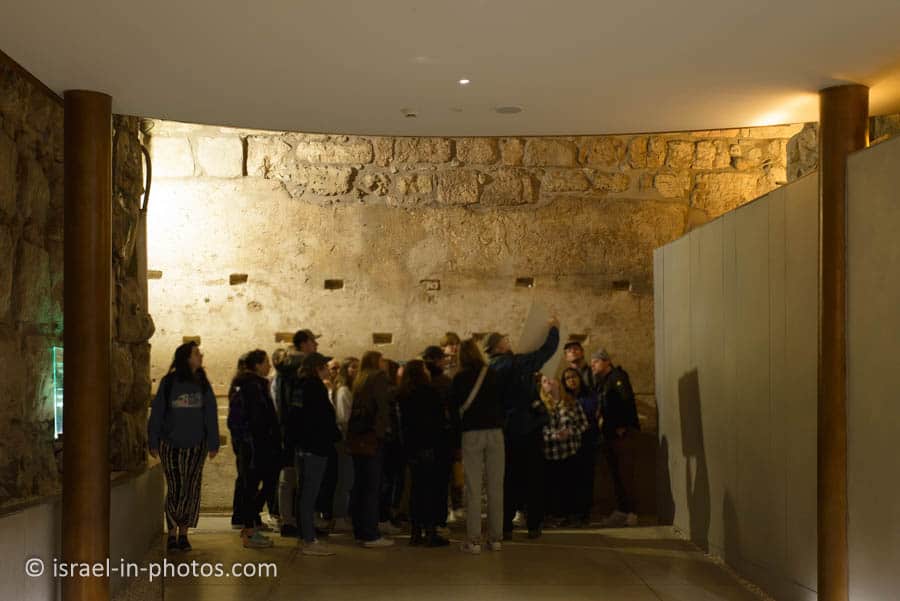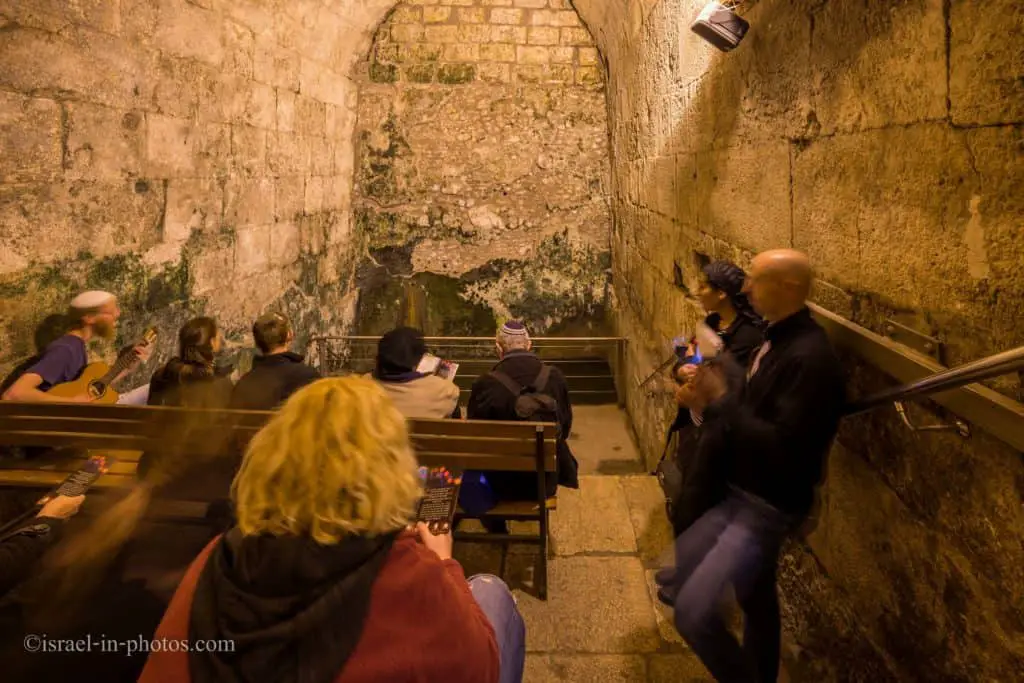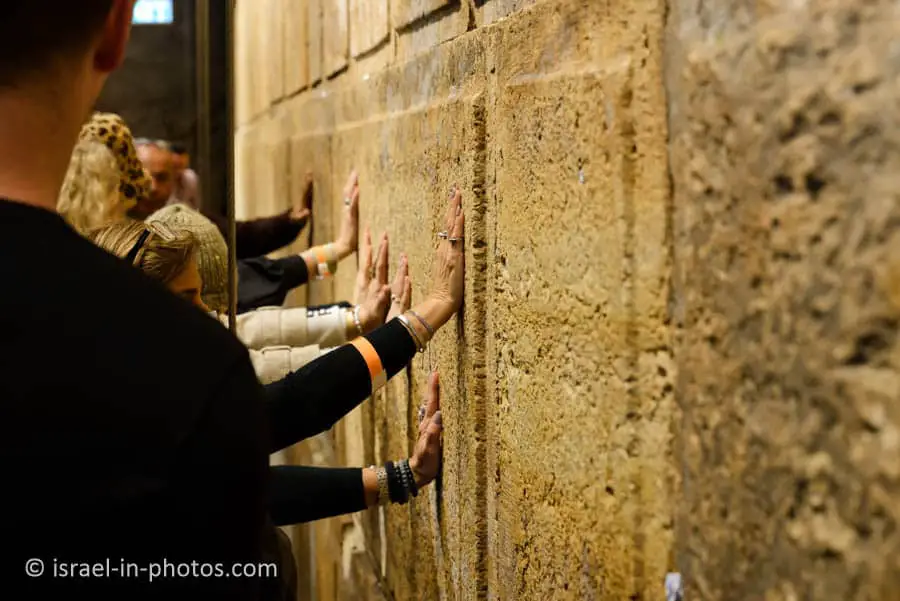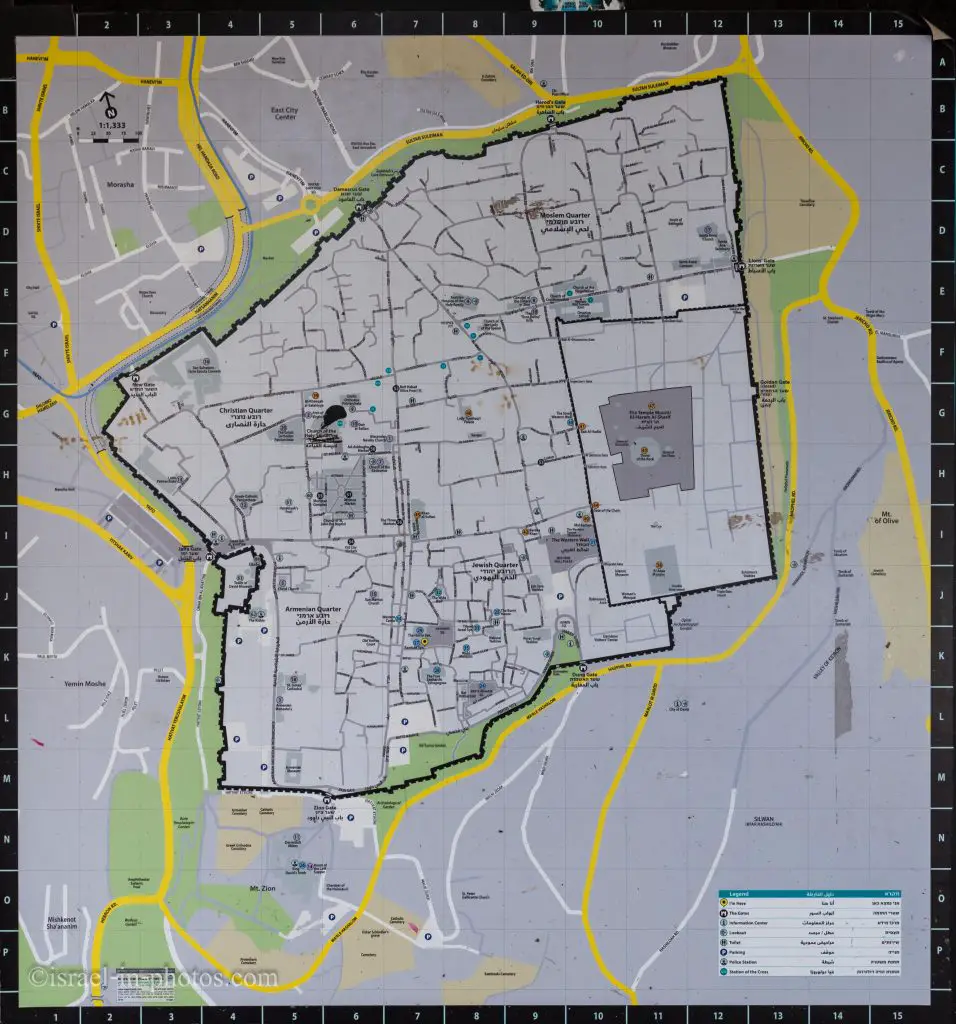Western Wall Tunnels, Jerusalem – Visitors Guide
The Western Wall Plaza shows only a small part of the wall. The Western Wall Tunnels offer tours of the underground sections.
Table of Contents
Map
Western Wall Tunnels are located by the Western Wall within the Old City Of Jerusalem. Dung Gate is the closest, but you can reach it from any entrance.
Directions for drivers: Link to Waze and Link to Google Maps
Directions for public transport: Link to Moovit
Interactive map of the area:
You can find the following map in several places in the Old City of Jerusalem.
Note: You can click on the map to enlarge it.
On the map above, the Western Wall is marked as #31 in square I10. And Western Wall Tunnels is located a little to the northwest (in the same square).
Directions
There are three entrances to the Western Wall plaza. And each entry is also an exit. Two of them are near Dung Gate, and one is in front of the Kotel (if you stand near the man’s area and turn around, you will see an entry on top of the stairs behind you). And though the Dung gate is the closest one, since you will probably visit other sites in the Old City, you can use any entrance to reach the Western Wall. For detailed directions, check the Old City Of Jerusalem.
Restrooms
There are big restrooms near the men’s entrance to the Wailing Wall. If the Western Wall is straight ahead, the toilets will be to your left.
Opening Hours
You must join one of the tours to visit the Western Wall Tunnels. Tours are available on Sunday – Thursday and half a day on Friday.
You can book a tour at the official site.
Entrance Fee
Adult: 38 NIS
Child / Soldier / Student / People with Disabilities / Senior Citizen: 25 NIS
Note: entrance fees were updated in July 2023.
Tours
| Name | Operation Hours | Duration |
|---|---|---|
| The Great Stone Route – The Original Western Wall Tunnels Tour | Sunday – Thursday: 09:00 – 22:00 Friday: 09:00 – 13:00 | About one hour |
| The Great Bridge Route | Sunday – Thursday: 07:00 – 23:00 Friday : 07:00 – 13:00 | About one hour |
As mentioned, you book a tour at the official site. And you should arrive at least ten minutes before the designated time. Several minutes before the start time, a local guide will come and call your group (group size is 18 – 35 participants).
Note: there are three different experiences. They are “The Journey to Jerusalem,” “The Chain of Generations Center,” and “A Look into the Past.” These are not tours with a guide but more “technological experiences” (like virtual reality).
Tours at the Western Wall Tunnels
Over the last fifteen years, I have probably joined five tours at the Western Wall Tunnels. On my first visit, we joined the classical tour (now called “The Great Stone Route”). We joined special tours during holidays several times, and in 2023, we participated in the Great Bridge Route.
And over time, you can see new findings and newly excavated areas. Moreover, I learned something new from each guide. Hence, we keep coming back every several years.
Another plus of the tunnels is that they are underground. Thus, you can visit all year round, regardless of the weather (both during the hot summer days or rainy winter days).
In the following sections, I will briefly describe some of the tours we participated in.
The Great Bridge Route
After years of development work and archeological preservation, we are happy to launch a new tour route in the Western Wall Tunnels: The Great Bridge route.
The Western Wall Tunnels will now include two fascinating tours –
The Great Stone tour (the classic route) includes a tour along the length of the Western Wall, a visit to the site closest to the Holy of Holies, and a visit to the Western Wall’s huge stone.The new route – The Great Bridge Route – will take visitors one more level under the Old City, where you will see the Great Bridge that led to the Temple Mount. This route will showcase different rooms and halls that served the people of that time, new and exciting findings, and a first glimpse at newly exposed courses of the Western Wall.
This is a unique and fascinating route under the Old City below the tremendous bridge that led to the Temple during the Second Temple period. The route passes exciting sites and findings from the Second Temple period and includes a look at a new exposure to the Western Wall.
Source: official site
Here is a short official video about this route:
In 2023 we joined this new route, and during this visit, we saw the new lobby. We showed our order inside the lobby, received color-coded paper bracelets, and waited for our guide.
The Bridge
Our guide took us to the first stop, where we watched a short movie.
The story of the bridge is also the story of the luxury and destruction of Jerusalem. The aqueduct on the bridge is an engineering marvel. To transport the water from Solomon’s Pools in Bethlehem, the Hasmoneans built an aqueduct about 23 kilometers long that passes through Armon Hanatziv, Mishkanim Shananim, and the Jewish Quarter. This engineering marvel created with advanced technology for its time testifies to the splendor of Jerusalem. This aqueduct served as one of Jerusalem’s main water sources for almost 2000 years until the days of the British Mandate.
The destruction of Jerusalem can be seen through the destruction of the bridge, which occurred twice in history. The first time it was the Hasmoneans themselves who destroyed it. Queen Shlomzion’s sons destroyed the bridge during a fight between them. The second destruction of the bridge was done during the temple’s destruction. The bridge’s destruction is the destruction of Jerusalem as a whole, the destruction of the Temple, and the exodus. Since the destruction of the Temple, the bridge has not been rebuilt.
Source: thekotel.org




The bridge was not only for pedestrians but also served as an aqueduct. And since there was water, a fountain was constructed on the bridge.
Here is a map of the route:

We started on floor -1 and watched the movie. Then we went down another floor and passed through various rooms, like the Herodian hall, Hall of Ages, and Mikveh, till we reached the Western Wall. Then we climbed one floor up and saw the model of the Second Temple. And lastly, we visited the nearby synagogue.
Magnificent Building
After the movie, we headed down to the magnificent building (or, as one of our guides called it: The Herodian Hall).
The new excavations in the Kotel tunnels discovered a magnificent building from the Second Temple period that was well preserved.
A magnificent public building was discovered under the bridge, which carried water to the Temple during the Second Temple period. It is decorated with many impressive architectural items and has one of the largest mikveh found. The use of this room remains a mystery.
According to estimates, this structure was built by the Jews who lived in Jerusalem around 30 AD, about forty years before the destruction of the Second Temple. The room was built at the base of the large bridge that extended from the residential area on the western hill to the temple. The level of the building is located at the foot of the Temple Mount near the main street. This street was full of shops outside the temple gates and where the pilgrims passed before ascending to the Temple Mount.
This building has preserved many elements that characterize the magnificent construction from the time of the Second Temple.
Several years before the destruction, the building underwent several changes. The large space of the room was divided into smaller areas, and the bridge above was widened. Following the expansion, the arches of the connection rested on the walls of the building. A mikveh was built in one of the new rooms, one of the largest found in Jerusalem from this period.
Despite the beauty and splendor of the great room, after the destruction, the building was partially destroyed, and on its ruins, the Romans built a large and magnificent bathhouse. The bathhouse of the Romans, which symbolizes hedonism, stands in complete contrast to the mikvah of purity, which was part of the building until then, and symbolized the holy work of the temple. The wall of the bathhouse cuts off the building from the Second Temple period, leaving two spaces and a narrow corridor between them.
Source: thekotel.org

Let’s head to the grand hall of the magnificent building.



Researchers think the grand hall was a parlor for hosting VIPs on their way to the Temple Mount. They also found an identical hall (the photos above).
At the end of the Second Temple period, when the western hall was no longer used, pools (probably Mikveh) were installed in the first hall.
Between the halls, you can see the remains of a fountain with Corinthian capitals.


Mikvehs
Adjacent to the magnificent building were found several mikvehs from the Second Temple period. For this reason, the area is called “the floor of the mikvah.” During the conservation work, drilling was done in the north wall of the mikvah, and as a result, a miraculous spring was discovered. The water flows from it and fills the mikvah throughout the year. But a greater wonder than this is that the drainage opening of the mikveh, which is more than two thousand years old, is still working, and thus the waters of the mikveh from the new source continue into the depths of the earth without interruption.
Source: thekotel.org


Wilson’s Arch
The Wilson’s Arch, the last arch at the base of the Great Bridge, is used today as an indoor prayer area in the Western Wall plaza. The arch was discovered as early as 1867 but was regulated for prayer only after the Six-Day War. Rabbi Getz described in his diary how the dirt removal process took place in a moving film by people and not by tractors that could destroy the pavement.
One of the biggest surprises of the excavation was the discovery of a theater-like structure under the arch. This theater can accommodate over 200 people, and because of that, it was probably used for limited performances (Odeon) or as a meeting place for the dignitaries of the people to make decisions by the leadership. The construction of this theater was never completed, and therefore some researchers believe that it was never actually used. Some researchers claim that its construction was stopped due to the outbreak of the Bar Kochba rebellion.
Source: thekotel.org







Then we climbed one floor up to the presentation room, where we saw a model of the Second Temple.



While visiting, we saw several other groups. And the group in the following photo is standing by the great stone.
The great stone refers to the biggest rock in the Western Wall. Its length is 13.6 meters. The estimated width is 3.5 – 4.5 meters. The original height was about 3.5 meters. The estimated weight is about 600 tons.

And our last stop was the nearby synagogue. I was impressed with the floor. As you can see, it glows. More precisely, the floor is made of special thin marble stones that allow light to pass through it.


Hanukkah Western Wall Tunnels Tour
In 2017, we joined the Western Wall Tunnels Tour. I preordered tickets online, and on the third candle of Hanukkah, we joined a tour at 17:00.
We parked at Giv’at HaTahmoshet and used the light train to arrive at the old city (you can find directions in the guide to the Old City Of Jerusalem).

The tour started at the Western Wall Tunnels. Thus, we hurried there.
Our tour started near the entrance, next to this arch to the right.

As it turns out, this is the bottom part of the bridge’s arch. Which bridge? The bridge that led to the Temple Mount. We are one level beneath the ground and almost at the top of a high bridge. There are at least four more levels to the ground.
Over centuries, people have built levels upon levels, and big parts of the old city are high above the ground.

Around fifty Mikveh were found near the Temple Mount. But only five of them are similar to this one. Most Mikveh has stairs from one side, but this one has stairs from all sides. Thus, researchers believe this is a public Mikveh.

Then we were led into a nearby room, which is also a Mikveh. In that room, a guitar player waited for us. We lit the candles and sang several Hanukkah songs.
This tour is more oriented toward archeology and history lovers. Thus, it is less suitable for kids. My daughter was an only child, and some parts were boring to her.

The Hall of Ages
Our next room was the Hall of Ages.

In this room, they performed depth excavations. Each layer belongs to a different period. Our guide turned on and off various lamps, and you could see more than two thousand years in front of you.
You can see the following periods: First Temple, Second Temple, Roman, Crusaders, Muslim, and Mamluk (I might have missed somebody). In this room, there were actual findings from the tenth century BC.
The Hall of Ages adjacent to the magnificent building symbolizes the constant connection of the people of Israel to Jerusalem. Despite time changes, nothing separated the nation of Israel from its eternal capital. In one space, we find finds from most periods of Jerusalem. The oldest finds in the room are pots dating back to the 10th century BC – the days of David and Solomon. A little newer, a floor from the days of King Hezekiah of Judah during the First Temple. In addition, you can find a Hasmonean water system, a wall from the Second Temple period, and arches from the later periods – the early Muslim, the Crusader, and the Mamluk periods.
Source: thekotel.org

Another interesting room was this one.

You can see two columns leading to two openings in the wall. These were fountains. You should remember that though today you see a small room, each wall of the room could have been built during a different period.
The Great Stone Route
The Western Wall of the Temple Mount (also known as the Kotel) is one of the most magnificent and significant remnants in Jerusalem from the days of the Second Temple, destroyed approximately 2,000 years ago.
The Western Wall stretches along almost half a kilometer, but today, the part exposed to all at the Western Wall Plaza is a mere 70 meters of it. This tour allows visitors to reach the segments of the Wall hidden from view and to touch the original and special stones that tell the story of the Jewish nation.
Visitors to the Western Wall Tunnels walk through ancient and fascinating spaces under the Old City with exquisite archeological findings, such as large stone vaults and arches, cisterns, an ancient water aqueduct trench that ends at the Strouthion Pool, and more.
This tour includes innovative virtual models. It is considered an international attraction and is one of the must-see sites in Jerusalem.
Source: official site
Summary
The tours at the Western Wall Tunnels are a lovely experience. And since they keep discovering new things, I return every several years. If you love such things, I recommend joining a tour.
Moreover, as I mentioned, since you will be underground, you can visit all year round, regardless of the weather.
Have you ever been to the Western Wall Tunnels? Tell us about your experience in the comments below.
That’s all for today, and I’ll see you in future travels!
Stay Tuned!
Additional Resources
Here are several resources that I created to help travelers:- Trip Planner with Attractions and Itineraries is the page that will help you create your perfect travel route.
- What is the Best Time to visit Israel? To answer this question, we will consider the weather, prices, holidays, festivals, and more.
- Information and Tips for Tourists to Israel will answer the most common questions tourists have about Israel (including safety, passports, weather, currency, tipping, electricity, and much more).
- Israel National Parks and Nature Reserves include a complete list, top ten, map, tickets (Israel Pass, Matmon, combo), and campsites.
- If you are looking for things to do, here are the pages for Jerusalem, Tel Aviv, Haifa, Sea Of Galilee, Akko (Acre), Eilat, Nazareth, Safed (Tzfat), and Makhtesh Ramon.








